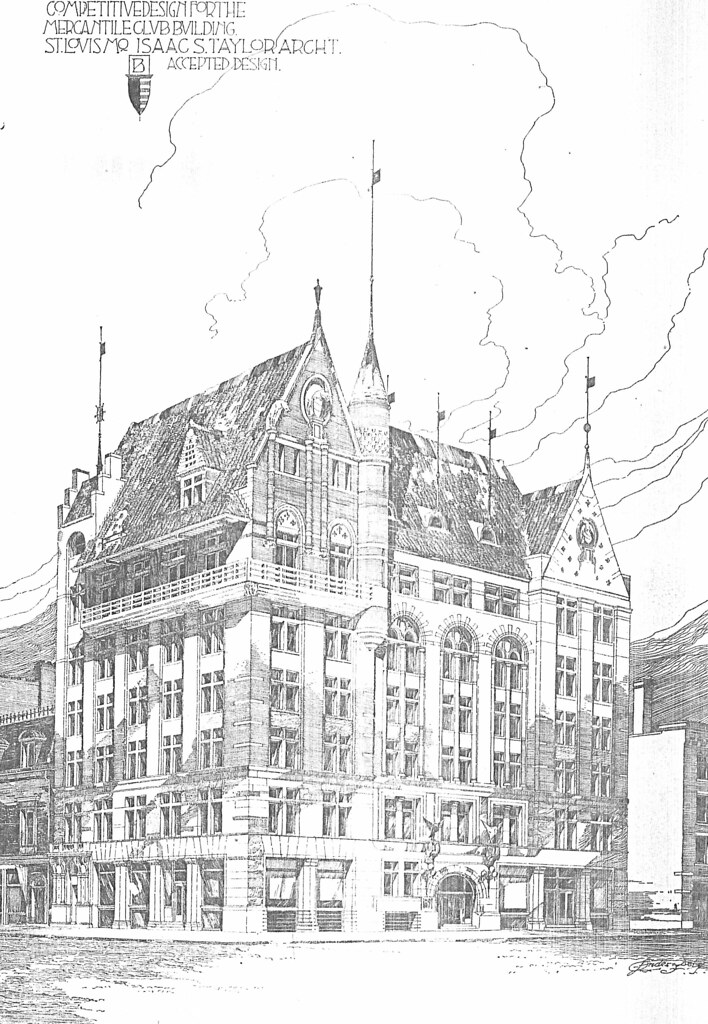 Recent discussion about development around the intersection of Seventh and Locust streets -- prompted by a plan to convert St. Louis Centre into a parking garage -- brings to mind one of that intersection's lost landmarks. The Mercantile Club stood at the southwest corner of that intersection, where now there is a parking lot.
Recent discussion about development around the intersection of Seventh and Locust streets -- prompted by a plan to convert St. Louis Centre into a parking garage -- brings to mind one of that intersection's lost landmarks. The Mercantile Club stood at the southwest corner of that intersection, where now there is a parking lot.The illustration here appeared in the Northwestern Architect in December 1891, showing the successful entry by Isaac S. Taylor in the Club design competition. Completed in 1892 according to the plan shown here, Taylor's design beat the work of other architects, including Louis Sullivan. (Had Sullivan won, Seventh Street would have been home to three of his works, with the Union Trust Building directly adjacent to the south.)
Taylor's design clearly was influenced by the Romanesque Revival architecture of H.H. Richardson as well as the architecture French Renaissance, which favored high-pitched roofs and turrets. The base of the building was Missouri granite, with brick above punctuated with terra cotta ornament.
The site had been occupied by the town home of Henry Shaw, which was relocated to a site on Tower Grove Avenue at the Missouri Botanical Garden. In 1891, the Mercantile Club was a rising and successful group consisting largely of downtown businessmen, and the site chosen for the club home was in the heart of members' commercial interests.
Later known as the Compton Building, the Mercantile Club fell in the early 1970s for the current surface lot.





4 comments:
Didn't Issac Taylor design the building just north of the Wainwright building also? It was a beautiful building, probably earlier and certainly smaller, than the Mercantile Club.
The new state building took it out. I remember Architect Steven Holl, unknown at the time, (late seventies), proposing saving the building against the written program for the site. (He also said he Arch should have arisen out of existing warehouse district)
While preservation efforts have improved over the years, the city government still hasn't a clue on how to integrate historic structures into the city proper.
In fact the culture of city government is still one that considers rehabs to be a hassle, especially on the North Side.
Greg, the DeMenil Buidling (1894) was indeed the smart, lyrical work of Ike Taylor.
Truly a loss, it must of been demolished before I returned to St. Louis.
The scale of the building should have probably been what St. Louis City followed for future development.
Instead St. Louis has a downtown with a few behemouths. The written planning strategy was stated to consider the height of the arch (finished much earlier than this demolition) as a priority. Yet there never has been an overall plan that would include historic buildings with that height concern.
Unlike New York or Chicago, St. Louis can ill afford mistakes. And many are still being made.
With Paul McKee the devastation continues. City officials do not concern themselves with city planning and most importantly the involvement of the citizens.
Their first priority is to serve corporate interests.
The real irony is that both the corporate world and government would would flourish beyond their dreams: only if they would create a path for the citizens to flourish along side them.
(Note: Discussion of how Helsinki, Finland is a low rise city, the average height around the height of the Mercantile Club, consider this along with other examples of low rise cities similar in size to St. Louis)
(Also note London with plans for numerous lines of sight open to the dome of St. Paul Cathedral, map available)
(Are there lines of sight that should be protected from North St. Louis towards the arch for instance)
Thanks for the DeMenil Info Michael, it was a great building, is there Issac Taylor buildings elsewhere?
The Eagleton building was allowed to be built to interfere with the Arch views in traveling east on 64, so why should the 22nd street interchange be treated any differently in McKeee's "grand plans"?
john
Post a Comment